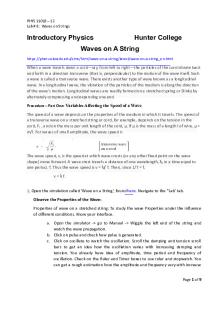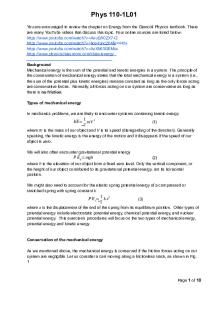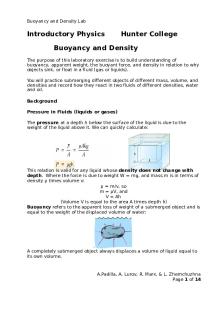PHYS 22 Lab 1 Charging by Induction PDF

| Title | PHYS 22 Lab 1 Charging by Induction |
|---|---|
| Author | Mimi Hsu |
| Course | Introductory Lab Ii |
| Institution | University of Vermont |
| Pages | 2 |
| File Size | 59.9 KB |
| File Type | |
| Total Downloads | 17 |
| Total Views | 131 |
Summary
Luke Donforth, Lab 1 Charging by Induction...
Description
Lab 1: Charging By Induction 1. Charge the acrylic rod and the teflon by rubbing them with the towel. One at a time, bring them near the electroscope. What do you observe? What's different, and what's the same? Describe what you can infer about the motion of charges in the system. When you bring the negatively charged Teflon rod near the electroscope, the leaves move away from the stem. This is because the stem and leaves become equally negatively charged, and they are repelled by each other. When you bring the positively charged acrylic rod near the electroscope, the leaves also move away from the stem. This suggests that the stem and leaves become equally positively charged. Both the Teflon rod and Acrylic rod show repulsion because the stem and leave become equally charged. This is because the electroscope is neutral, and when you bring the negatively or positively charged rod near the charges travel down. 2. Ground the top plate of the electroscope (by touching it with your finger, or a grounding cable) and bring the charged teflon and then acrylic near. What do you notice? What's different compared to when you weren't grounding the plate? Describe what you can infer from the motion of charges in the system. We are charging through induction because the electroscope was grounded using our fingers. There is no movement of electrons because the leaves don’t move away from the stem. When you use the negatively charged teflon rod, your body will absorb the electrons. This is because the system will be positive. The positively charged acrylic rod will give electrons to the system, this creates an overall negative charge. When we did not ground the plate, we observed repulsion. 3. Start by grounding the top plate of the electroscope, and leave your finger there. Bring the charged Teflon near the electroscope plate. Break the grounding connection (i.e. remove your finger) THEN take away the teflon. You should see the leaves separate (if not, try again with closer spacing, if that doesn't work, check with your TA). If the teflon is negatively charged, the net charge on the electroscope after the ground connection and teflon have been removed? Describe the motion of charges through the various steps. Note, if you hear a crackle or snap, charges jumped through space and may have messed up your results, try again. We grounded the top plate of the electroscope by holding a finger on top. After we brought the charged Teflon charge close to the electroscope. Despite the first trial where we observed repulsion, there was no movement of the leaves. We can infer that the motion of charges in the system were obstructed. The finger acted as a reservoir for the charge. After removing our finger, the net negative charge was transferred to the electroscope. The negative charge of the stem and leaf resulted in repulsion. 4. With the electroscope inductively charged as above, bring a charged acrylic rod nearby. What happens to the leaves? What does that mean is happening to the charges? Bring the charged teflon back near the electroscope. What happens to the leaves? Describe the motion of charge in the system. When acrylic rod is brought near the electroscope, the stem and leaf are attracted, charge absorbed by hand. When the teflon rod is brought close to the system, the stem and leaf are
attracted to the system. There was a subtle crackle heard. This trial was repeated and the crackle was present.
5. Now inductively charge the electroscope from the acrylic. Ground the plate with your finger, bring the charged acrylic rod near, remove your finger, remove the rod; and you should see the leaves separate. Bring the charged acrylic rod back near. What happens? Bring the charged teflon near. What happens? What is the net charge currently on the electroscope? Describe the motion of charges as you charged the electroscope and brought other charged objects near. When the system is grounded and the positively charged acrylic rod is brought near, there is no movement. When the finger and rod are removed, the leaves repel from the stem. After the charged acrylic rod is brought near, the stem and leaf are attracted to the rod. The acrylic rod will give electrons to the system, this creates an overall negative charge. Since the acrylic rod is still positively charged, when brought near the system, the stem and leaves would come together. The negatively charged Teflon rod when brought near the electroscope will cause the stem and leaf to repel each other. 6. Now we'll use the electrophorus (the aluminum disk on an insulating handle). Rub the teflon sheet with the towel. Place the aluminum disk flat on the sheet. Briefly ground the disk while it's on the teflon. What do you notice? Bring the disk near the electroscope? What do you notice? When you rub the teflon sheet with the towel, this creates a negative charge. The aluminum becomes negative. When we ground the aluminum disk using a finger, and remove it from the sheet, it becomes positive. When placed near the electroscope, the stem and leaf will repel. This indicates the overall net charge of the system is positive. 7. As in 3 and 5, charge the electroscope; using the electrophorus as the charged object. Investigate the electroscope with the charged teflon and acrylic. What's the net charge on the electroscope? What was the charge on the electrophorus? Describe your deductions, and the motion of charge (including the motion of charge onto the electrophorus). When we would bring the teflon rod near the electroscope, the stem and leaves would be attracted. When we would bring the positively charged acrylic rod near the electroscope, the stem and leaves would be repelled....
Similar Free PDFs

Sydney Lab Induction quiz
- 2 Pages

Phys lab 4 - Lab report
- 10 Pages

Phys lab report 2
- 14 Pages

LAB 3 PHYS 1429
- 3 Pages

Phys lab 8 - Lab report
- 9 Pages

Phys lab 5 - Lab report
- 10 Pages

Phys lab 10 - Lab report
- 14 Pages

PHYS Lab Report 3
- 7 Pages

Lab 201 Phys 2 Lab - Lab
- 4 Pages

Triboelectric Charging
- 2 Pages

Phys 208 Lab Report # 3
- 3 Pages

LAB Report #4 phys 224
- 5 Pages
Popular Institutions
- Tinajero National High School - Annex
- Politeknik Caltex Riau
- Yokohama City University
- SGT University
- University of Al-Qadisiyah
- Divine Word College of Vigan
- Techniek College Rotterdam
- Universidade de Santiago
- Universiti Teknologi MARA Cawangan Johor Kampus Pasir Gudang
- Poltekkes Kemenkes Yogyakarta
- Baguio City National High School
- Colegio san marcos
- preparatoria uno
- Centro de Bachillerato Tecnológico Industrial y de Servicios No. 107
- Dalian Maritime University
- Quang Trung Secondary School
- Colegio Tecnológico en Informática
- Corporación Regional de Educación Superior
- Grupo CEDVA
- Dar Al Uloom University
- Centro de Estudios Preuniversitarios de la Universidad Nacional de Ingeniería
- 上智大学
- Aakash International School, Nuna Majara
- San Felipe Neri Catholic School
- Kang Chiao International School - New Taipei City
- Misamis Occidental National High School
- Institución Educativa Escuela Normal Juan Ladrilleros
- Kolehiyo ng Pantukan
- Batanes State College
- Instituto Continental
- Sekolah Menengah Kejuruan Kesehatan Kaltara (Tarakan)
- Colegio de La Inmaculada Concepcion - Cebu



